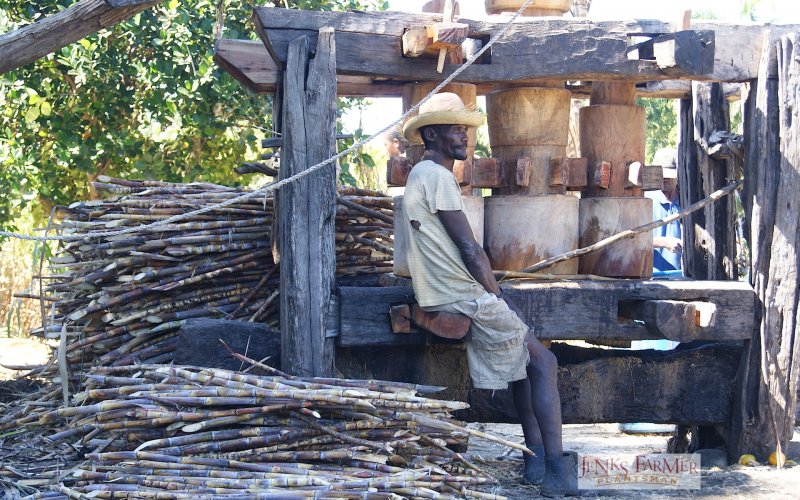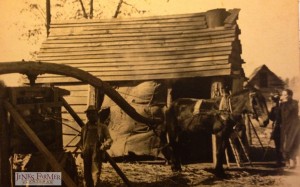
Sugar Cane Mill. What Goes Around…
Before I went, I thought that working in Haiti might be depressing. But it wasn’t. I felt connected to my daddy– like I was living life off the land, the way he grew up– and that was amazing.
The biggest day of connection involved an old style sugar cane press. We stopped on a little farm to watch the guys work; everything in one place: sugar cane right from the field, animals for power and transport, the press, the cooking pot, the packing supplies and finished product of crystallized cane sugar.
The moment I glimpsed this press from the car window, I had a flash of a photo of my father: a little blond boy, his grandmother and a mule, standing beside a press just like this one. From the moment I walked up, I had warm tears in my eyes. Daddy always wanted us to love and understand the simple beauty of living off the land. He probably romanticized it, judging by the look on my great grandmother’s face. In this picture, at that time, her home, Gravel Hill, had fallen into ruins; bad decisions about cotton farming plunged the South into chaos, years before the rest of the US felt the Depression, so they were making cane syrup not for cash, but as their only bit of sugar.
I stopped by the nursing home yesterday and asked Daddy’s best friend about cane presses. He said with that inflection of ‘boy you don’t know much, but I love you anyway’, “No we didn’t sell it; nobody had any money to buy it.” And he taught me a new word: Su-cat. Who knows how to spell it. When you boil the cane juice to get the water out and leave the sugar, there’s a constant froth that has to be lifted off. Those bubbles all go into a barrel and turn back into liquid. “Weeks later,” Ben said, “the black folks would pop a hole in the bottom and get out a pretty good liquor.” Those bubbles, that froth, is su-cat.
It’s not just people of the depression era who remember these sorts of mills, though. They are around now; you can watch them work at Blizzard Branch, SC. And a peer and friend of mine remembered one when I sent a picture of this one in Haiti. Rebecca Bull Reed grew up near Santee, SC. She says:
The farmer who lived down the road from us (Herman Way) used to grind his own sugarcane with a set up similar to what I think I see in your photo. He used a mule, though. It was always in early September….We gave his grandson a ride home from school and were always excited to see this. We’d hop out of the car and watch, and he’d cut sticks for us to chew. I’ll always remember the pile of squeezed cane in the center.
Rebecca and I are about the same age and this is part of how I found optimism in the farms of central Haiti. It wasn’t that long ago that, right here, we were poor and making a living, eating off the land, working in raggedy cloths. It wasn’t that long ago that we were as connected to the land and our bodies as these guys who were proud to show off their cane mill.
ETC: If you want to grow sugarcane at home; just buy some cut pieces in the specialty grocery or more often in a Mexican grocery. Look closely, if it’s been waxed, go somewhere else. The waxed ones might sprout, but it’s just weird that anybody waxes sugarcane. You can lay them in warm soil and wait for the sprouts to come from the nodes, or stick them upright in a bucket, cover with dirt about halfway. It seems like it takes forever, but once growing, give them lots of water and compost and they’ll get giant. There’s a dramatic cultivar called ‘Pele’s Smoke’ that has purple leaves and stems. I think Glasshouse works has it. Once you get cane, you’ll always have it if you save some cut canes over winter — just bury them in a warm spot or keep them dormant in a warm basement.[Not a valid template]

